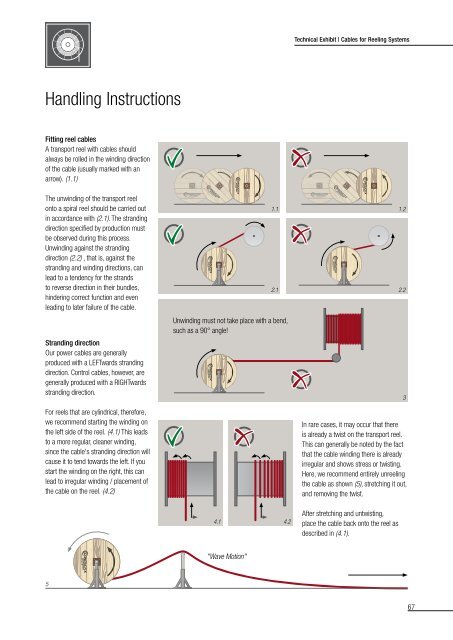Conductix-Wampfler Cables for Reeling Systems
Conductix-Wampfler Cables for Reeling Systems
Conductix-Wampfler Cables for Reeling Systems
Create successful ePaper yourself
Turn your PDF publications into a flip-book with our unique Google optimized e-Paper software.
Handling Instructions<br />
Fitting reel cables<br />
A transport reel with cables should<br />
always be rolled in the winding direction<br />
of the cable (usually marked with an<br />
arrow). (1.1)<br />
The unwinding of the transport reel<br />
onto a spiral reel should be carried out<br />
in accordance with (2.1). The stranding<br />
direction specified by production must<br />
be observed during this process.<br />
Unwinding against the stranding<br />
direction (2.2) , that is, against the<br />
stranding and winding directions, can<br />
lead to a tendency <strong>for</strong> the strands<br />
to reverse direction in their bundles,<br />
hindering correct function and even<br />
leading to later failure of the cable.<br />
Stranding direction<br />
Our power cables are generally<br />
produced with a LEFTwards stranding<br />
direction. Control cables, however, are<br />
generally produced with a RIGHTwards<br />
stranding direction.<br />
For reels that are cylindrical, there<strong>for</strong>e,<br />
we recommend starting the winding on<br />
the left side of the reel. (4.1) This leads<br />
to a more regular, cleaner winding,<br />
since the cable's stranding direction will<br />
cause it to tend towards the left. If you<br />
start the winding on the right, this can<br />
lead to irregular winding / placement of<br />
the cable on the reel. (4.2)<br />
5<br />
4.1<br />
1.1<br />
2.1<br />
Unwinding must not take place with a bend,<br />
such as a 90° angle!<br />
"Wave Motion"<br />
4.2<br />
Technical Exhibit | <strong>Cables</strong> <strong>for</strong> <strong>Reeling</strong> <strong>Systems</strong><br />
1.2<br />
2.2<br />
In rare cases, it may occur that there<br />
is already a twist on the transport reel.<br />
This can generally be noted by the fact<br />
that the cable winding there is already<br />
irregular and shows stress or twisting.<br />
Here, we recommend entirely unreeling<br />
the cable as shown (5), stretching it out,<br />
and removing the twist.<br />
After stretching and untwisting,<br />
place the cable back onto the reel as<br />
described in (4.1).<br />
3<br />
67


